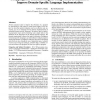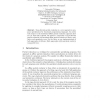199 search results - page 1 / 40 » Implementing Circularity Using Partial Evaluation |
PADO
2001
Springer
13 years 9 months ago
2001
Springer
Complex data dependencies can often be expressed concisely by defining a variable in terms of part of its own value. Such a circular reference can be naturally expressed in a lazy...
PADO
2001
Springer
13 years 9 months ago
2001
Springer
nt Abstractions . . . . . . . . . . . . . . . . . . . . . . . . . . . . . . . . . . . . . . . . . . . . 63 J¨orgen Gustavsson, Josef Svenningsson Implementing Circularity Using Pa...
ICFP
2010
ACM
13 years 6 months ago
2010
ACM
Partial evaluation aims to improve the efficiency of a program by specialising it with respect to some known inputs. In this paper, we show that partial evaluation can be an effec...
TMI
2008
13 years 4 months ago
2008
In this paper, we introduce a new algorithm for 3-D image reconstruction from cone-beam (CB) projections acquired along a partial circular scan. Our algorithm is based on a novel, ...
ASIAN
1998
Springer
13 years 9 months ago
1998
Springer
Abstract. Type-directed partial evaluation is a new approach to program specialization for functional programming languages. Its merits with respect to the traditional offline part...


